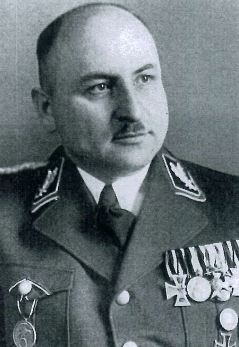Zöberlein, Hans (NSDAP)
- Date of birth:
- September 1st, 1895 (Nürnberg, German Empire)
- Date of death:
- February 13th, 1964 (München, Germany)
- Service number:
- SS-Nr.: // NSDAP-Nr.: 869
- Nationality:
- German
Biography
Zöberlein was born the son of a shoemaker and learned the mason and stone mason trade. During the First World War, Zöberlein was promoted to Vice Sergeant and was awarded the Iron Cross II and I Class and the Bavarian Golden Medal for Bravery (the highest Bavarian war award for NCOs and men).
After the end of the war, Zöberlein joined the Freikorps Epp under Franz Ritter von Epp. It was involved in the suppression of the Soviet republic in Bavaria. In 1921 he joined the NSDAP and the SA for the first time. In November 1923 he took part in the Munich Hitler-Ludendorff putsch.
After the re-establishment of the NSDAP in the spring of 1925, following the party's temporary ban after the failed coup, Zöberlein rejoined it (membership number 869). In January 1928 he was entrusted with the management of the Munich SA as the successor to Georg Seidenschwang. In 1929, Zöberlein and Max Zankl designed the SA badge, which was supposed to represent a combination of the so-called victory rune and the man rune.
By attending secondary schools, Zöberlein qualified as an architect. He practiced this profession in Munich in the 1920s, apparently without much success. Originally, he was supposed to work with the architect Otto Schiedermaier to rebuild the Barlow Palais (later the "Brown House") in Munich's Brienner Strasse, which the NSDAP had bought in July 1930 and which was intended for their office and party headquarters. This did not happen, however, since Hitler preferred the more renowned architect Paul Ludwig Troost.
In the SA, which was disempowered after the "Röhm Putsch", Zöberlein only advanced slowly. In 1943 he was appointed SA Brigadeführer. He was a member of the SA culture committee and president of the politically neutral order of the Bavarian Bravery Medal according to the statutes, which enjoyed great prestige.
In Munich he was an NSDAP city councilor and also made a name for himself as a cultural politician through his works in Munich. In the autumn of 1933 Zöberlein was already in discussion for the city's annual literature prize - at that time the alternative candidate was Georg Britting, for whom Zöberlein, among others, voted, who was also on the committee. Britting received the award for 1935 in 1936. The decision was made unanimously in favor of Zöberlein in 1933 after postponement in the same group.
In 1934 Zöberlein became head of the newly founded cultural office, responsible for the visual arts, literature and theater, including all libraries, as well as music and film.
In the summer of 1935, the design of the bridgehead of the Munich Ludwigsbrücke by Karl Knappe was a point of contention, especially since Knappe was outlawed and had a professional ban. Zöberlein was the person responsible on paper for the design, which aroused Hitler's displeasure. Zöberlein was then informed of Hitler's request that he resign in favor of Ferdinand Liebermann, which also included the loss of the management of the cultural office. Zöberlein followed suit.
In Penzberg, a town south of Munich, shortly before the end of the war, a group of residents had deposed the Nazi mayor and wanted to bring about the surrender of the city to the approaching American troops in order to avoid bloodshed and destruction. Thereupon Zöberlein left on 28/29. April 1945 as the leader of a "Werewolf" squad, execute several citizens of this mining town as traitors. This massacre came to be known as the Penzberger Murder Night. Zöberlein was sent to the Kornwestheim internment camp on August 21, 1945, but was transferred to the Regensburg internment camp on January 13, 1947, where he remained until June 24, 1948. Zöberlein was sentenced to death in 1948 for the night of the Penzberg murder and was in the internment camp in Nuremberg-Langwasser from June 24, 1948 to February 2, 1949. The Munich Higher Regional Court rejected the appeal for appeal as unfounded, but changed the sentence to life imprisonment with a permanent loss of honor due to the legal situation that has changed in the meantime. On February 2, 1949, he was transferred to the Munich Stadelheim correctional facility.
In 1952, the arbitration chamber proceedings for denazification led to Zöberlein being classified as an "incriminated person" and to a sentence of two years in a labor camp, deprivation of property and a ten-year professional ban. In 1958 Zöberlein was given exemption from prison for health reasons until his death on February 13, 1964 in Munich.
Do you have more information about this person? Inform us!
- Period:
- First World War (1914-1918)
- Period:
- First World War (1914-1918)
- Period:
- First World War (1914-1918)








